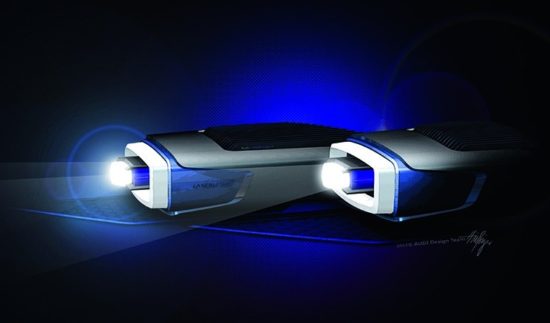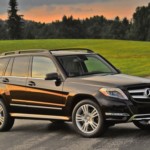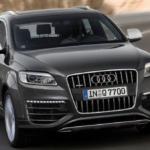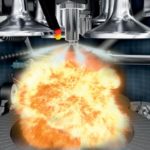Laser Vs. LED lights
Laser lights are smaller, light better, consume less electricity and last longer! Sounds perfect! What is it really about?

The BMW i8 is the first production car to optionally offer laser lights (LED lights are standard)
Thomas Edison constructed the first incandescent light bulb in 1879, and it has remained the most massive source of artificial light to this day. Of course, light bulbs have improved over time and given more light with less energy consumed, but such technology has its limits, so a little over 20 years ago, cars (for headlights) began to install xenon lights that gave twice as much light between 2.800 and 3.500 lumens) which was also of better quality, ie closer to daylight. Along with xenon headlights, LED technology appeared at the end of the 80's, first for the rear lights, and in 2004 they were used for the first time as headlights.
However, most of the cars on the market today have halogen lights, while only high-end cars have xenon (or LED) in the series, so the higher quality lights still have a lot to pay for. While most of the drivers are 19th century technology, the announcement of the installation of laser lights is an additional technological step forward in relation to LED lights, although they are basically similar technologies.
Farther and brighter
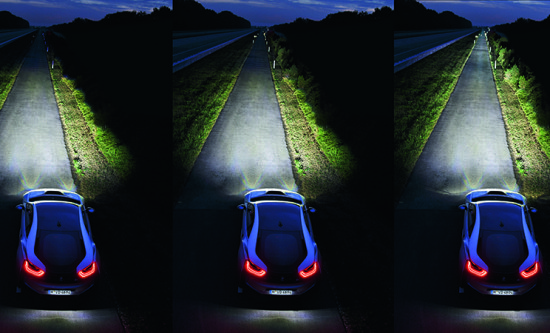
Beam Comparison: LED dipped beam (left), LED dipped beam (center), laser light (right)
However, don't expect your next car to have laser lights! What we can expect is the increasing use of LED lights that will gradually push xenon lights and classic light bulbs out of the market, primarily because these are lights that, although much more expensive, illuminate the road more efficiently, consume less energy, last longer than cars and require very little space. In recent years, even more spectacular so-called OLED lights that allow you to create different lighting effects on cars and the like. But at the same time, we are witnessing the introduction of lasers in car lighting, first of all with premium models, and over the years as the price falls, and probably even wider. The word laser originated from the first letters of the phrase "Light Amplification by Stimulated Emission of Radiation", which could be translated as light created by stimulated emission of radiation. By bringing energy, the electrons in the atoms of individual semiconductors rise to a higher energy level, releasing photons and returning to a lower energy level and so on. The result is directed beam or beams such as you could see with laser pointers, bar code readers and the like. What is the advantage of a laser over an LED? First of all, lower energy consumption, which in practice looks like this: a pair of halogen headlights "pulls" about 120 W of electricity, LEDs about 40 W, and a laser less than 30 W. In other words, LED lights with one watt of energy produce 100 lumens of light while with the same energy from the laser you get 170 lumens. Also, laser lights have a much stronger light source for the same surface compared to LED, so the low beams of the new BMW i8 (which has LEDs as standard, optional laser headlights) in the LED version have 50 candelas per square millimeter while laser lights on the same model they have 580 candelas per mm2. Laser lights have a much longer range, so the halogen beam "throws" up to 125 meters, LED up to 300 meters, and laser up to 700 meters. Admittedly, Audi claims that their matrix LED lights on the R18 race illuminate a kilometer of track in front of the car.
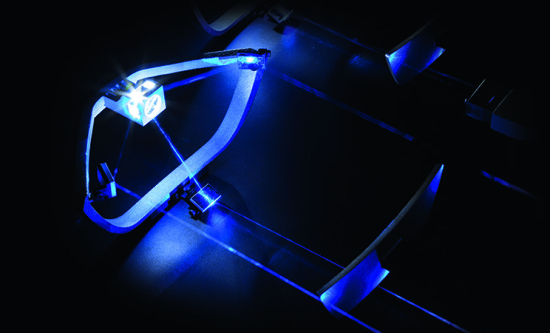
The laser beam is passed through a phosphorus layer to produce white light and through a mirror system to obtain a scattered beam.
Miniature dimensions
Although the LED (or LED light source) is very small, about 1 mm, the dimensions of the laser diode are even 100 times smaller, or about 10 μm, although BMW points out that they do not intend to radically reduce the size of the headlights (although they could) because are essential for the appearance of the car, but this fact will reduce the depth of the light assembly and greatly facilitate the work of engineers. Laser light is monochromatic, ie it has only one wavelength, so it can have only one color. BMW uses a blue laser whose rays are transmitted through a layer of phosphorus that blocks certain photons, whereby they stimulate the relaxation of photons with yellow light, which in combination with blue gives white light. This is necessary because the law prescribes that lighting vehicles must use white light. The mention of laser beams immediately raises the question of the potential danger to the eyes of people who might find themselves exposed to this light. At BMW, they point out that there is no danger to people because the laser beams (which are otherwise very directional) are scattered through several mirrors into a harmless final beam that is still very directional, but much less than the original beams. However, due to various safety regulations, the high beam on bmw The i8 will only be able to activate at speeds above 40 km / h to prevent anyone from staring at a powerful and static laser light source.

The beam of laser lights is twice as long as that of LED lights
Comparison of laser and LED technology
|
Recommendation of similar texts:

Hi there, I am Mladen and I am an auto enthusiast. I started this blog years ago to help like minded people share information about latest cars, car servicing ideas, used car info, exotic cars, and auto technology. You will find helpful articles and videos on a wide variety of cars - Audi, Mercedes, Toyota, Porsche, Volvo, BMW and much more. Ping us if you have anything cool to share on latest cars or on how to make older cars more efficient, or just want to say hi!

